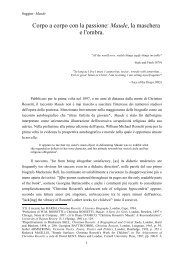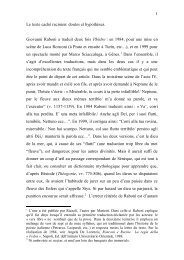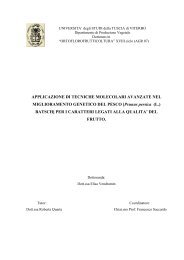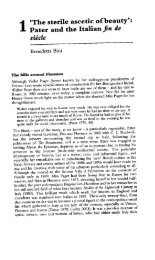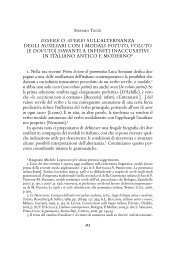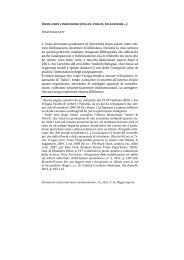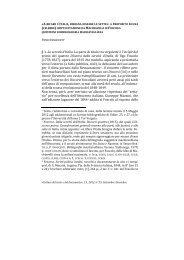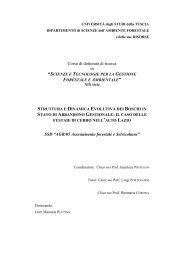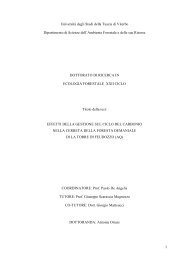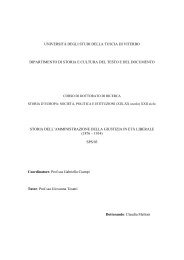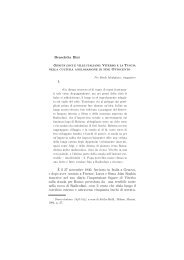drivers of soil respiration of root and microbial ... - Unitus DSpace
drivers of soil respiration of root and microbial ... - Unitus DSpace
drivers of soil respiration of root and microbial ... - Unitus DSpace
You also want an ePaper? Increase the reach of your titles
YUMPU automatically turns print PDFs into web optimized ePapers that Google loves.
3.4.2. Allocation patterns<br />
84<br />
Kuzyakov <strong>and</strong> Domanski (2000) reviewed grassl<strong>and</strong> C budgets based on pulse labeling<br />
studies <strong>and</strong> found that typically for cereals about 30% <strong>of</strong> total assimilates is transferred into the <strong>soil</strong>.<br />
Of this quantity about half is found in <strong>root</strong> biomass, the rest <strong>of</strong> the belowground allocation being<br />
respired through <strong>root</strong> <strong>respiration</strong>, excreted by <strong>root</strong> exudation or found in the <strong>soil</strong> microorganisms or<br />
<strong>soil</strong> organic matter. The relative C translocation <strong>of</strong> pasture plants into <strong>soil</strong> was 1.5-2 times higher<br />
than that <strong>of</strong> cereals. Leake at al. (2006) for sub mountain grassl<strong>and</strong>s with lower productivity <strong>and</strong><br />
<strong>soil</strong> temperatures <strong>and</strong> slower turnover rates reported a lower proportion <strong>of</strong> C allocation to <strong>root</strong><br />
biomass (12-22% <strong>of</strong> the shoot pulse 13 C). Two distinct pools <strong>of</strong> C could be recognized from our<br />
data: a fast-turning over pool that becomes enriched in a pulse following labeling <strong>and</strong> a slower<br />
turning over pool that remains enriched, but at much lower levels for long after the pulse labeling<br />
have been performed. An equal quantity <strong>of</strong> recently fixed C was allocated to below <strong>and</strong> above<br />
ground <strong>respiration</strong> during the first day, which represent a pool with a high turnover rates. However,<br />
the origin <strong>of</strong> this C is uncertain with a great probability that it is coming just from the aboveground<br />
plant parts (see above).The C with a lower turnover rates on the contrary was allocated preferably to<br />
<strong>root</strong> <strong>respiration</strong>. Consequently, the aboveground growth <strong>and</strong> maintenance <strong>respiration</strong> is fuelled<br />
mainly by the assimilates <strong>of</strong> the current day, while in <strong>root</strong> <strong>respiration</strong> the C with higher MRTs<br />
values is involved.<br />
The <strong>root</strong>/shoot ratio reported by Gadghiev et al. (2002) for various grassl<strong>and</strong> ecosystems <strong>of</strong><br />
Central Asia varies from 7 to 17, stating that grassl<strong>and</strong>s invest heavily in the production <strong>of</strong><br />
belowground biomass. The <strong>root</strong>/shoot ration <strong>of</strong> Amplero (data not shown), estimated in 2007 varied<br />
in the course <strong>of</strong> the year from 10 to 18, confirming that the most part <strong>of</strong> the net primary production<br />
is concentrated belowground. Consequently, the majority <strong>of</strong> the new coming C is expected to be<br />
allocated to belowground also, <strong>and</strong> would be used then to support the growth <strong>of</strong> the new <strong>root</strong>s <strong>and</strong><br />
the maintenance <strong>of</strong> existing one. The beginning <strong>of</strong> June in Amplero, when the pulse labeling was<br />
performed is characterized by an intensive accumulation <strong>of</strong> <strong>root</strong> biomass (data <strong>of</strong> 2007, are shown<br />
in chapter 2 <strong>and</strong> 6). Nevertheless, Carbone <strong>and</strong> Trumbore (2007) showed that the allocation patterns<br />
vary slightly during the growing season, with an increased proportion <strong>of</strong> recently assimilated C<br />
allocated to aboveground during the late growing season, which is associated with flowering period,<br />
when aboveground biomass reaches its peak. Further experiments with a pulse labeling isotope<br />
technique application are needed for the detailed study <strong>of</strong> the changes in seasonal C allocation<br />
patterns.




